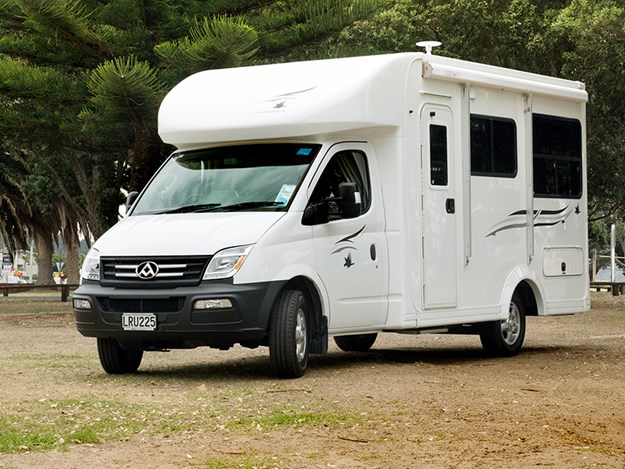
Buying a used motorhome can be something of a daunting experience. Unlike, say, a used car purchase, buying a pre-loved motorhome not only involves the mechanical bits but the house components as well. But with a little homework, you can get a very nice RV at a very good price.
Case in point: the KEA Breeze L640 motorhome. It’s part of what RV Super Centre call their Signature Range – an ex-rental model that has fairly low mileage and has been refurbished prior to sale. It was not a particularly old model, with just under 32,000km on the clock.
Research is important
One of the benefits of purchasing a used motorhome is that it’s possible to do a bit of online research, not only about the motorhome but also the cab chassis. It means that, particularly on older models, anything that really needs looking out for prior to purchase can be checked out. And, in this case, since the KEA Breeze model is also a rental, it’s possible to ‘try before you buy’.A little differently to most motorhomes in New Zealand, this Breeze had a Chinese-built LDV V80 front-wheel drive chassis. It’s not totally Chinese, though, because it does have a few items like the (Italian) VM Motori-designed 2.5-litre turbo diesel engine, Bosch fuel injection system, and the Euro-designed AMT gearbox.
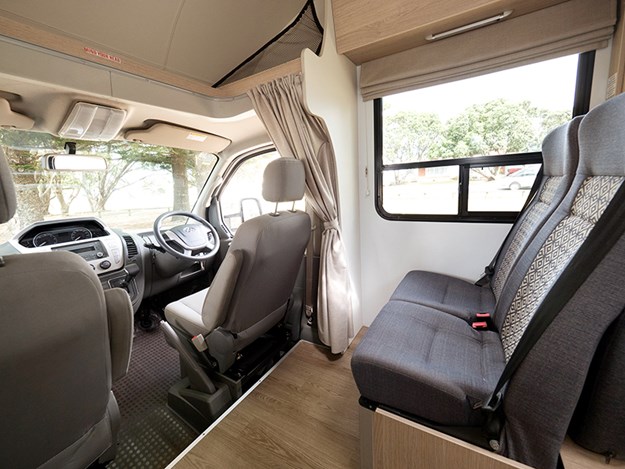
Take a seat
Before doing just about anything else, as with any motorhome, I’d suggest just sitting in your prospective purchase and having a good look around. Change seats if you can and go through all the motions of living in a motorhome that you can think of.The Breeze does have a ‘step-up’ from the front cab which leads to a layout for four people. Directly behind the driver’s seat is a two-person seat, with seatbelts. Behind this is the bathroom, leaving space for the entry door directly behind the passenger seat, and for the kitchen bench along the nearside wall. In the rear is the much-favoured club-style lounge – with windows all round – which can be made up into a 1500mm x 2100mm bed at night. And for the two additional sleepers, there’s a dropdown 1400mm x 2000mm bed above.
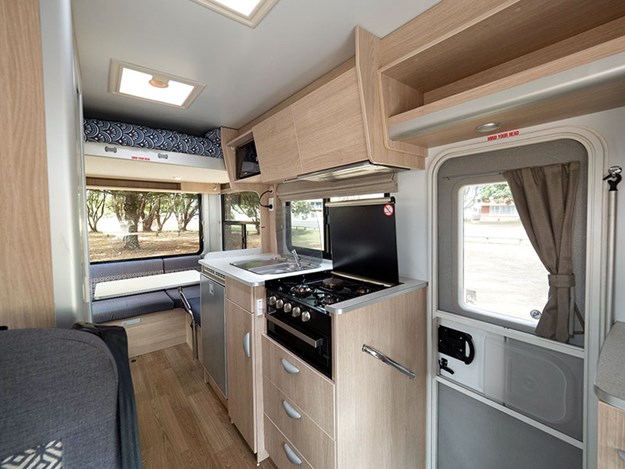
Lounging
With the upper bed out of the way, the club lounge seats four people without too much trouble. A single pole mounting is used for the table; it’s not set in the floor but rather on the side against the kitchen bench. Although it may not always keep the table totally stable, it can be swung against the kitchen bench to be used at a bench extension. Two LED downlights are fitted under the bed base for nighttime illumination of the table area.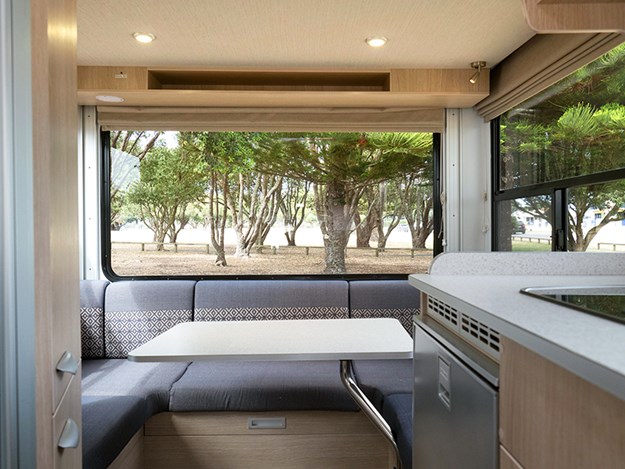
Move around
When viewing a motorhome for purchase, it’s a good idea to get the family onboard and move around. See how often you get in each other’s way. For most people that’s something easily worked out, but it’s always worth going through the motions, just in case.While moving around, open and close all the windows, cupboard doors and everything else that opens and shuts, just to make sure everything works. Have a play with the light switches and blinds. Note where the power points are and think about whether you’ll need extension cords or powerboards.
While you’re looking around, consider the general condition of your purchase. There will be signs of wear and tear, but that will depend to some degree on the age of the motorhome and how good the pre-sale refurbishment has been. The Breeze I looked over had been scrubbed up quite nicely.
General storage is another consideration. Travelling light is always to be encouraged, but sometimes even just the basics can take up quite a bit of space. A downside of the dropdown bed arrangement is that it means no overhead lockers in the rear area. However, there is a handy double cupboard between the bathroom cubicle and the rear seat. In addition to that, there’s a small cupboard behind the passenger seat and a shelf above the doorway area.
One of the benefits (from a driving point of view) of the KEA Breeze is that it’s a fairly small motorhomeand thus easily manoeuvrable on the road. The downside is that things are a little more confined inside.
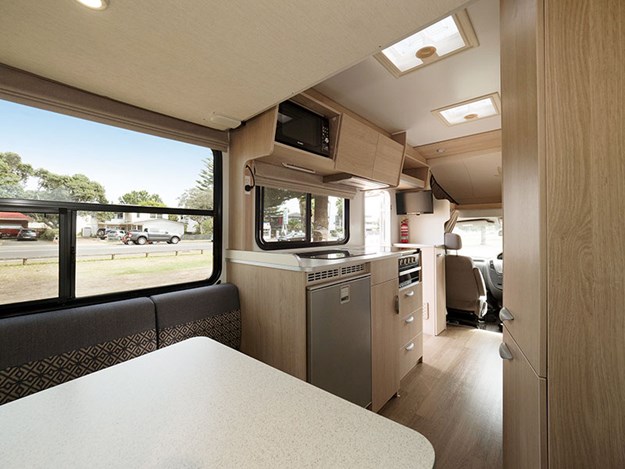
Compact kitchen
I’m a fairly simple cook, so I don’t require too much in terms of kitchen ‘extras’. My favourite weapons of choice are the microwave oven and the grill, but I know people who use the former as a bread bin! Others I know are much more creative in their catering and have different and more exacting requirements than I do.In the Breeze, most of the kitchen bench area is taken up by the four-burner hob with grill underneath and a stainless steel sink/drainer. Both appliances have smoked glass tops, which offer some much-needed extra bench space when they’re closed. Under the sink is a 130-litre Isotherm fridge which leaves space alongside for a cupboard and three drawers.
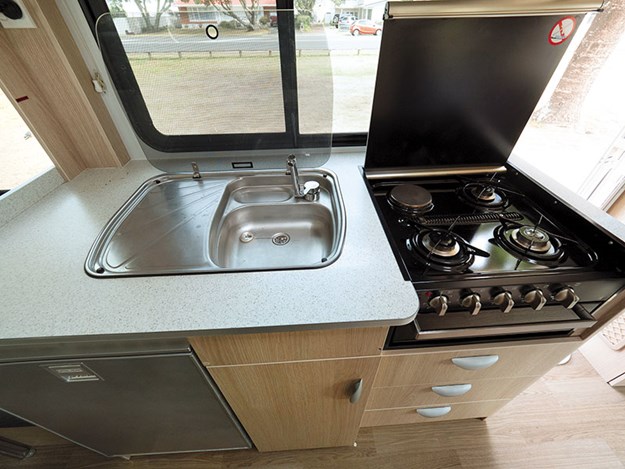
As this is an ex-rental, the drawers have holes cut out to suit plates, cups and bowls. This does take up space, but it works well to keep items secure, reduces rattling during driving, and makes packing so much easier. Three overhead lockers are fitted above the bench.

Compact bathroom
Another petite item is the combo bathroom, which includes a Thetford cassette toilet, small corner washbasin, and flexible hose shower. Other fittings include the towel rail and vent fan.While you are checking things out, turn the water pump on and give it a brief run in both kitchen and bathroom. Also take a look around under sinks, washbasins and anywhere else where water might leak – it’s usually fairly obvious.
Step into the shower cubicle and see if you can turn around easily. Functionally, I’d consider a bathroom of this size as more for occasional overnight use rather than extended holidays or full-time, but it does depend very much on how you travel.
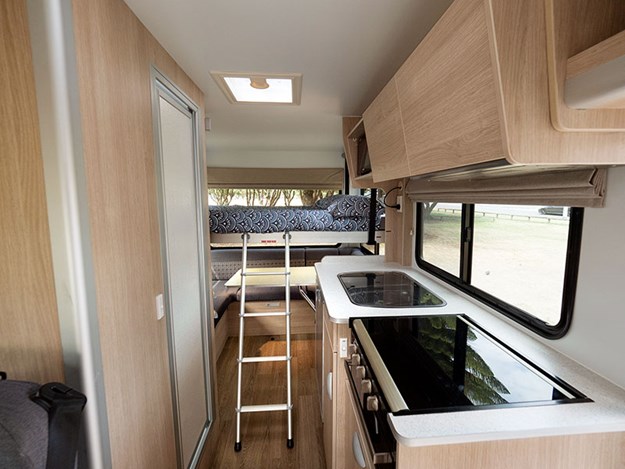
Rear bed
KEA has opted for the hand-operated dropdown bed. That is a little unusual as most are electric, but the dropdown mechanism is quite easy to use and there’s little that can go wrong with it. The bed can be lowered fully but, of course, if you have two people sleeping on the bed below, it can only be lowered halfway. If you’ll be travelling with four people, then try a few heights to see if it’s practical for your use.Outside
In addition to inspecting the inside of a motorhome, the outside is definitely worth a look too. Do a thorough body inspection. Most ex-rental motorhomes will have a few scratches and dents. I was surprised to find this particular Breeze didn’t have any, which was impressive.The Breeze fibreglass body does have a somewhat square look about it, apart from the front view, where the low profile look is quite good. Large tinted glass windows are fitted around the rear, with the side ones having lower slide openings. The door is a fairly standard style with a top half window and a separate (non security) insect screen.
There is external storage on both sides of the motorhome – not particularly large but big enough for the basics. There is also storage for the usual items such as gas cylinders, the hot water heater, toilet cassette, and electrical connections. Not all rental motorhomes come with an awning but the Breeze does. It’s a Cvana model, which has the double advantage of being fairly easy to use, yet is quite sturdy.
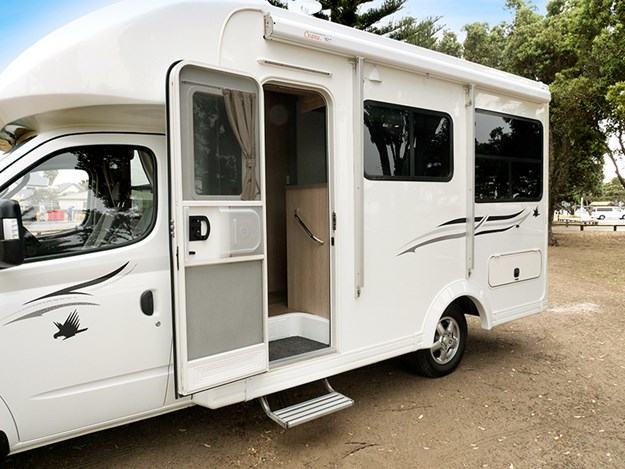
On the road
For obvious reasons, a test drive is mandatory. It’s also a good opportunity to listen for squeaks, rattles and any other odd noises, but also to determine if you will feel comfortable driving (or being a passenger) over long distances. In this particular model, the LDV cab is quite basic compared to the recent generations of European-built cab chassis, but then again, it’s also a lot cheaper.An oddity about the LDV is that the instrumentation and controls are all in the centre of the dashboard. That’s done to make it easier for the manufacturer when producing left or right-hand drive vehicles, but it takes a bit of getting used to. All the other controls are more or less where they should be, including the AMT gear shift, which is not far from the left hand.
The 2.5-litre turbo diesel was a reasonable performer, but the AMT gearbox was a bit hesitant changing gear in the lower ranges. That’s not anything new. Early Mercedes Sprinter and Ducato AMTs were/are like that as well.
I’m not a mechanical expert, and while I’m happy to have a good look over the ‘house’ part of any prospective motorhome purchase, I would be asking someone with a bit more mechanical ability to check out the engine components.
Summary
Although the Breeze is classed as a four-berth motorhome, it’s really a two berth with facilities for occasional extra guests. From my inspection, it didn’t have too many signs of rental use and, with only 32,000km racked up, it should give plenty of good service.For those who like the layout but would prefer a European chassis, then the Breeze is also available with Mercedes- Benz Sprinter underpinnings. It’s more expensive of course.
I’ve mentioned a few buyer tips for this particular motorhome, but they can be applied to any motorhome you’re considering buying.
Kea Breeze L640 specifications
| Engine | 2.5L LDV turbo diesel 100kW/330Nm |
| Transmission | 6-speed AMT, front-wheel drive |
| Berths | 2 |
| Approx overall length | 6400mm |
| Approx overall width | 2300mm |
| Fresh/grey water tank | 100L/100L |
| Gas | 1 x 9kg |
| GVM | 4490kg |
Pros
- For an ex-rental, overall condition was quite good
- Ideal for those who desire a small motorhome
- Rear lounge/dropdown bed combination
- General lighting
Cons
- Limited external bin storage
- Basic LDV chassis
- No cab swivel seats
Find motorhomes, caravans and RVs for sale in NZ





